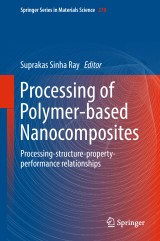Details

Processing of Polymer-based Nanocomposites
Processing-structure-property-performance relationshipsSpringer Series in Materials Science, Band 278
|
96,29 € |
|
| Verlag: | Springer |
| Format: | |
| Veröffentl.: | 15.09.2018 |
| ISBN/EAN: | 9783319977928 |
| Sprache: | englisch |
Dieses eBook enthält ein Wasserzeichen.
Beschreibungen
<p>Processing of polymer nanocomposites usually requires special attention since the resultant structure—micro- and nano-level, is directly influenced by among other factors, polymer/nano-additive chemistry and the processing strategy. This book consolidates knowledge, from fundamental to product development, on polymer nanocomposites processing with special emphasis on the processing-structure-property-performance relationships in a wide range of polymer nanocomposites. Furthermore, this book focuses on emerging processing technologies such as electrospinning, which has very exciting applications ranging from medical to filtration. Additionally, the important role played by the nanoparticles in polymer blends structures has been illustrated in the current book, with special focus on fundamental aspects and properties of nanoparticles migration and interface crossing in immiscible polymer blend nanocomposites.</p><p>This book focuses heavily on the processing technologies and strategies and extensively addresses the processing-structure-property-performance relationships in a wide range of polymer nanocomposites, such as commodity polymers (chapter 1), engineering polymers (chapter 2), elastomers (chapter 3), thermosets (chapter 4), biopolymers (chapter 5), polymer blends (chapter 6), and electrospun polymer (chapter 7). The important role played by nanoparticles in polymer blends structures in particular is illustrated.<br>The book is useful to undergraduate and postgraduate students (polymer engineering, materials science & engineering, chemical & process engineering), as well as research & development personnel, engineers, and material scientists.</p>
Nanocomposites based on commodity polymers, Prasanna Kumar S Mural and Suprakas Sinha Ray.- Nanocomposites based on engineering polymers, Vincent Ojijo and Suprakas Sinha Ray.- Nanocomposites based on rubbers, Reza Salehiyan and Suprakas Sinha Ray.- Nanocomposites based on thermosets, Vincent Ojijo and Suprakas Sinha Ray.- Nanocomposites based on sustainable polymers, Orebotse Botlhoko Joseph and Suprakas Sinha Ray.- Nanocomposites based on polymer blends, Reza Salehiyan and Suprakas Sinha Ray.- Electrospun polymer nanocomposites, Koena Selatile, Prasanna Kumar S Mural and Suprakas Sinha Ray.
<div>Professor Suprakas Sinha Ray was born in 1973 in India and completed his PhD studies at the University of Calcutta in 2001, and then postdoctoral fellow at Toyota Technological Institute and Laval University studying the structure-property relationship in nanoclay-containing polymer nanocomposites. He started working on fundamental understanding to real applications of polymer-based nanostructured materials when he joined the CSIR as a group leader. These studies advanced and broadened when he appointed as a chief researcher (level II, highest SET position in CSIR) and director of the DST-CSIR National Centre for Nanostructured Materials and growing to the present time with postdoctoral fellows, students, collaborators and industrial partners worldwide. Currently, more than 80 researchers, engineers and technologists are working with him. Prof. Ray is one of the most active and highly cited authors (his articles have been cited more than 14700 times, google scholar, h factor 44, Google/Scopus, S.S.Ray, S. Sinha Ray, S. Sinha-Ray), in the field of soft-nanostructured materials and his work has been featured on various international journal cover pages on 14 different occasions. Recently, he has been rated as a Top 1% of most impactful and influential scientists (Chemistry, Materials Science and 22 Science disciplines) by Thomson Reuters Essential Science Indicators, 2014. In 2011, he also has been rated as a Top 50 high impact chemist in the world (Feb. 2011, Thomson Reuter, probably youngest researcher in this list, 1.2 mil Chemists). So far he has given more than 30 plenary/keynote/invited presentations in various international conferences and organized/co-organized a number of international conferences. Ray is the author of 2 books, 16 book chapters on various aspects of polymer-based nano-structured materials & their applications, and author and co-author of 250 articles (including 17 review articles) in high-impact international journals, 14 articles in peer-review international conference proceedings; 30 articles in national and international conference proceedings. He also has 4 patents and 7 new demonstrated technologies shared with colleagues, collaborators and industrial partners. His team also commercialized 16 different grades of polylactide nanocomposites. Over the last 10 years, 32 PhD/Master students graduated under his direct supervision. Currently, he is serving as an Associate Editor/Editorial Board member of the RSC Advances, Macromolecular Materials and Engineering, Applied Nanoscience, Journal of Nanoscience and Nanotechnology, International Journal of Plastic Films and Sheeting, Applied Nanoscience, Journal of Nanomaterials, and Heliyon.</div><div><br></div>
<div>Processing of polymer nanocomposites usually requires special attention since the resultant structure—micro- and nano-level, is directly influenced by among other factors, polymer/nano-additive chemistry and the processing strategy. This book consolidates knowledge, from fundamental to product development, on polymer nanocomposites processing with special emphasis on the processing-structure-property-performance relationships in a wide range of polymer nanocomposites. Furthermore, this book focuses on emerging processing technologies such as electrospinning, which has very exciting applications ranging from medical to filtration. Additionally, the important role played by the nanoparticles in polymer blends structures has been illustrated in the current book, with special focus on fundamental aspects and properties of nanoparticles migration and interface crossing in immiscible polymer blend nanocomposites.</div><div><br></div><div>This book focuses heavily on the processingtechnologies and strategies and extensively addresses the processing-structure-property-performance relationships in a wide range of polymer nanocomposites, such as commodity polymers (chapter 1), engineering polymers (chapter 2), elastomers (chapter 3), thermosets (chapter 4), biopolymers (chapter 5), polymer blends (chapter 6), and electrospun polymer (chapter 7). The important role played by nanoparticles in polymer blends structures in particular is illustrated.</div><div>The book is useful to undergraduate and postgraduate students (polymer engineering, materials science & engineering, chemical & process engineering), as well as research & development personnel, engineers, and material scientists.</div>
Focuses on the polymer processing and the impact it has on the structure, property and performance of the nanocomposites Elucidates the role of nanoparticles in polymer blend nanocomposites Addresses emerging technologies such as electrospinning
Diese Produkte könnten Sie auch interessieren:

Introduction to Focused Ion Beams

von: Lucille A. Giannuzzi, Lucille A. North Carolina State University

128,39 €















